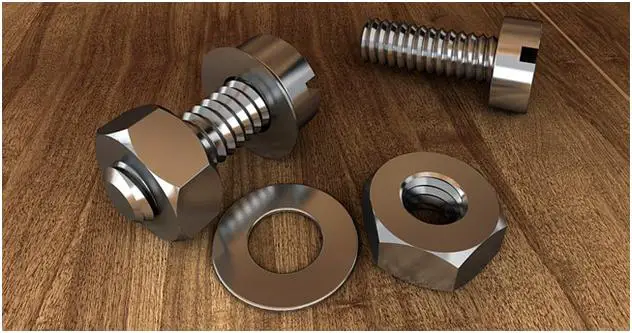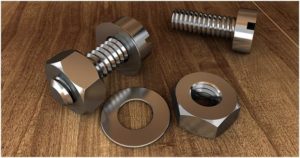If you are one of many Americans who always find themselves wondering which washer should be inserted before the other when using lock and flat washers, you are not alone. This post gives you the answer and explains why this lock washer flat washer placement is best.
I consider myself pretty handy around the house and have always been comfortable doing minor repairs and DIY assemblies. When it comes to lock washer flat washer placement, I’ve never really known what the rule is. I often just try two or three times with the washers in different positions and go with whatever feels best. What really is the correct order?
Image courtesy of Pixabay
What Is A Washer?
A washer is a thin, disk-shaped plate with a hole in the middle. It is used with a nut to secure a bolt or other threaded fastener. A washer could also serve as a spacer, wear pad, locking device, a spring or to reduce vibration. Washers are made of either plastic or metal. Washers also serve to reduce galvanic corrosion when used on aluminum surfaces with steel screws.
Types of Washers
There are two main types of washers:
Flat washers: These are general use washers used under the head of a bolt or nut. Their flat surface provides a smooth bearing surface and distributes weight over a wide area. They are also referred to as plain washers.
Lock washers: Their uneven surface prevents threaded fasteners from loosening caused by friction and joint movements. These are also called split washers.
Flat washers and lock washers are often used together, but many people still cannot get the lock washer flat washer placement right. Flat washer then lock washer or vice versa, which one is correct?
Which One Goes In First?
Ideally the lock washer goes into the threaded fastener first followed by the flat washer. This way the lock washer adds tension to the fastener assembly. It creates pressure on the bolt or nut (depending on where it is used) to prevent the assembly from loosening when it is exposed to vibration.The flat washer, through its surface area, serves to distribute the clamping pressure caused by tightening the fastener in place. It could also serve as a spacer when the bolt is a bit bigger than the ideal size for the assembly. The flat washer can be used on the bolt side, nut side or both.
If the assembly calls for other types of washers or hardware elements besides these two, they should go on before the lock washer. This way the tension created by the lock washer holds them all in place.
It is very important that you do not tighten the lock washer too much. Over tightening it gradually flattens its tension-causing rough surface which renders it useless.
Washers are made from a variety of materials such as:
- Steel
- Copper
- Brass
- Aluminum
- Alloys
- Plastic
Metallic washers are by far the most common.
Corrosion Affects Efficiency of Fasteners
Corrosion of metals is one of the most common causes of inefficiency or total failure of fasteners. This is a natural phenomenon which cannot be wished away. Corrosion is a process in which metals are gradually destroyed by chemical and electrochemical reactions with their environment. It produces red oxide (what we all know as rust) which is a product of the metal’s reaction with oxygen in the air.
Corrosion causes metal loss, cracking, and in extreme cases total failure of the fastener. It is not always possible to use corrosion resistant metals to make fasteners, so other methods have to be applied to mitigate the process. Coating of the metal is one of the most common mitigation methods. Steel bolts and washers are coated with zinc flakes. This coating is applied on the bolts and washers like paint. The metal is then baked. When several coats of zinc are used, the coating also serves as a friction-proof coating. Other methods used to mitigate corrosion include Teflon coating and hot dip galvanizing.
Conclusion
It is arguably the most common bolt and washer related question asked. Now that the lock washer flat washer placement question is sufficiently answered. You can now take on your DIY home improvement projects and assemblies with a new confidence. Keep in mind that bolts, washers and nuts may be small parts of the construction process, but proper placement is crucial for the stability and durability of the structure or product. Improper placement may not be noticeable at a glance, but is a risk you don’t want to take.
FAQ
How effective are lock washers?
The necessity and effectiveness of lock washers has been questioned in the recent past. Some experts insist that they are no different from flat washers. They say that when a lock washer is tightened in place, it is flat on the substrate, so it gives just as much resistance as a flat washer.
How can I remove a lock washer?
- Use a socket or adjustable wrench to remove the nut from the bolt
- Use a flathead screwdriver to pull the lock washer off
- If it doesn’t move, work around the circumference of the washer with the screwdriver to loosen it.
What’s the right way to use star washers?
Have the jagged side facing the bolt. The aim is to make sure the bolt nut does not turn.
How can I differentiate between screws and nails?
Screws have threads on the shaft, but nails are smooth. Nails can be driven into a material using a hammer, but screws cannot.
How can I prevent screws from coming loose?
- Apply thread locking glue to the threads when installing
- Fill in the screw hole with material (like a chunk of wood) to increase friction
- Wrap some sewing thread on the threads of the screw.


